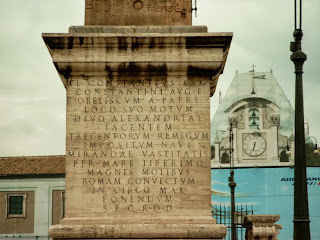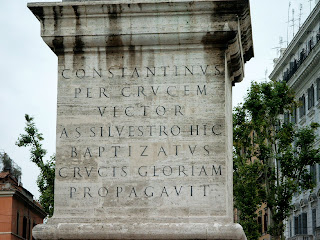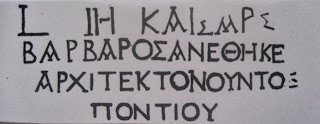The Problem of the Obelisks:
From a Study of the Unfinished
Obelisk at Aswan
The
Problem of the Obelisks by R. Engelbach, published by T. Fisher Unwin Ltd. in
1923, was reprinted by Nabu Press in 2010 and by Forgotten Books in 2012. This
old book is still interesting and valuable.
Reginald (or
Rex) Engelbach (1888-1946) was a British Egyptologist. On the title page of this book he is described as Chief Inspector of Antiquities in Upper (i.e. southern) Egypt
I –
Obelisks and Quarries
II –
Description of the III - Setting out an Obelisk
IV –
Extraction of an Obelisk
V –
Transport of an ObeliskVI – Erection of an Obelisk
VII – Some
ancient Records
VIII - A
History of certain Obelisks and their ArchitectsIX – Removals of Obelisks in modern Times
At the end
of the book we find Appendix I (Dates of Egyptian kings) and Appendix II (Spelling
of Egyptian names) and a general index. The text is illustrated by 44 photos
and drawings in black-and-white.
As you can
see from the table of contents, this is not a traditional book about ancient
Egyptian obelisks. The focus is on the mechanical and technical problems
related to obelisks, and the starting point is the broken or unfinished obelisk,
which is still lying in the ancient quarry at Aswan Egypt
The
subtitle – From a Study of the unfinished Obelisk at Aswan
In his
preface Engelbach explains that this volume (published in 1923) is a popular
version of a scholarly report The Aswan Obelisk (published in 1922). The
popular version is an easy read. The technical stuff is not difficult to
understand. The text and the illustrations complement each other well. The illustrations
help the reader understand the point he is trying to make in the text.
Unfortunately, illustrations
are not always placed next to the relevant passages in the text. You have to
flip back and forth between text and illustration. This is a bit annoying,
but it is only a minor problem.
The Aswan 137 feet long. If it had been completed, the
weight would have been ca. 1,168 tons. It would have been the tallest and the
heaviest obelisk in the world.
The workers
had to give up, because they found several fissures in the granite. They tried
to evade this problem and create a smaller obelisk instead, but even this plan had to be abandoned, because
the fissures were too widespread.
We do not
know when this took place; perhaps around 1500 BC, but the ancient obelisk is
still lying in the ancient quarry, and when we study this unfinished project,
it is possible to find the answer to some of the questions that we have about
the ancient obelisks (chapters I and II).
In chapters III-VI the author follows an obelisk step by step from the moment when it is excavated in the quarry until it is standing in front of an ancient temple. The author presents and evaluates several interpretations of the material evidence. In some cases he has even conducted a practical experiment on a small scale. As far as I can see, his account is reliable, and his conclusions are sound.
In chapter
VII he reviews the ancient literary evidence about obelisks, which is quite
limited. The Egyptians set up many obelisks, but they never bothered to give us
a detailed account about how it was done. That is why the methods employed are
still the subject of intense discussion today.
In chapter
VIII the author presents some of the royal architects, who worked for the
pharaohs. We know some names and sometimes a bit more about them, because they
were buried in individual tombs in Thebes. Here are a few examples:
** Ineni, who
worked for Thutmosis I, was buried in a tomb known as TT 81.
** Sennemut,
who worked for Hatshepsut, was buried in a tomb known as TT 71.
** Other
architects are Dhutiy (TT 11); Puimre (TT 39); Menkheperra-sonb (TT 86); and
Beknek-honsu (TT 35).
Ancient
Egyptian names are tricky, because they were written without the vowels. Modern
scholars do not always use the same forms as Engelbach did in the beginning of
the 20th century. For instance he says Hatshepsowet, while modern
scholars say Hatshepsut.
When discussing how a heavy monument was moved on
land, Engelbach refers to a wall painting found in the tomb of Dhuthopte in
el-Bersheh. Modern scholars call this person Djehutihotep and the location Deir
el-Bersha.
In chapter
IX the author completes his account by telling us the story of four famous obelisks,
which were erected in foreign lands in modern times:
The first
obelisk had been transported from Egypt Rome Rome
The second
obelisk was transported from Luxor Egypt France 1833. In 1836 it was erected in the Place de
la Concorde in Paris
The third
obelisk was transported from Alexandria Egypt England 1878. In 1878 it was erected on the
Embankment of the River Thames. [See Cleopatra’s Needle, 1893]
The fourth
obelisk was transported from Alexandria Egypt US 1880. In 1881 it was erected in Central Park in New York
Engelbach
wrote his book almost one hundred years ago, but in my opinion it is still
relevant. If you are interested in ancient Egypt
on the granite in the ancient quarry.
The broken or unfinished obelisk seen from the top.
The ancient stone block is 137 feet long and weighs ca. 1,168 tons.
The unfinished obelisk.
The broken obelisk.
In this picture you can see one of several fissures in the granite.
The broken obelisk seen from the bottom.
Notice the group of visitors standing near the top of the monument.
This can give you an idea of the scale.
The broken obelisk seen from the bottom.
Notice the group of visitors standing near the top of the monument.
This can give you an idea of the scale.
* * *
The ancient stone block is 137 feet long and weighs ca. 1,168 tons.
The unfinished obelisk.
The broken obelisk.
In this picture you can see one of several fissures in the granite.
The broken obelisk seen from the bottom.
Notice the group of visitors standing near the top of the monument.
This can give you an idea of the scale.
The broken obelisk seen from the bottom.
Notice the group of visitors standing near the top of the monument.
This can give you an idea of the scale.
Figure 21 in Engelbach's book:
"Transport of
the statue of Dhuthopte, from his tomb at el-Bersheh."
Today this person is
known as Djehutihotep and the location as Deir el-Bersha.
Figure 24 in Engelbach's book:
"Boat of
Queen Hatshepsôwet from the Punt reliefs at Dêr el-Bahari."
Today the queen is
known as Hatshepsut and the location as Deir el-Bahari.
* * *











































